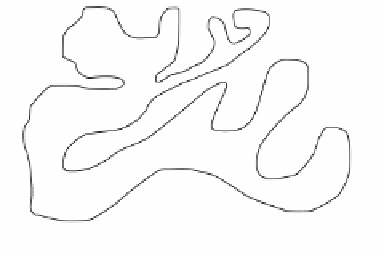Graphics Reference
In-Depth Information
Figure 6.8.
Does a simple closed curve have an
inside and outside?
q
p
inside
outside
knots, that is,
imbeddings
, can be distinguished. On an intuitive level, the question
is, given a pile of string, what test will determine if it is knotted and when are two
knots the same?
The classification of surfaces:
The problem is to determine computable invariants
that will differentiate between different surfaces such as the sphere and the torus.
The Jordan curve theorem:
A circle in the plane clearly divides the plane into two
parts - a bounded part that is the inside of the circle and an unbounded part, the
outside. A natural question to ask is whether every simple closed curve in the plane has
the same property. Is there again a well-defined inside and outside? See Figure 6.8.
Does every curve that starts at an inside point
p
and ends at an outside point
q
have to
cross the curve at some point? Surprisingly, this seemingly obvious fact is difficult to
prove for general curves. The first partial proof of this fact is due to C. Jordan in 1893.
We shall look at some aspects of combinatorial topology in this chapter. A lot of
the material is derived from [AgoM76]. The study of topological invariants is impor-
tant not just to mathematicians but also to anyone interested in geometric modeling
and computer graphics and this chapter will be a warm up for the theory that will be
developed in the next chapter. The next section will try to explain in broad terms what
topology is all about. Section 6.3 defines simplicial complexes and polyhedra. The
latter form the core of the spaces studied by topology. Section 6.4 introduces cutting
and pasting. These basic operations in topology are then applied in Section 6.5 to
solve the surface classification problem.
6.2
What Is Topology?
The topics introduced in the introduction of this chapter may seem like they are all
quite separate, but in fact they all have something in common. For example, the shape
or size of faces and sides of a simple polyhedron is unimportant in Euler's formula,
the shape of a country is unimportant to the coloring of a map, and whether or not
a graph is planar does not depend on the length or straightness of its edges. In other
words, we were dealing with properties of objects that were invariant under certain
deformations. What are the allowable deformations under which the properties stay



